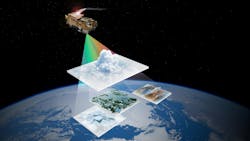Metop-SG satellites to boost extreme weather nowcasting and climate monitoring
KOUROU, French Guiana - At 02:37 CEST on 13 August 2025, the Metop-SGA1 satellite of the European Organisation for the Exploitation of Meteorological Satellites (EUMETSAT) will lift off from Kourou, French Guiana, on an Ariane 6 rocket. The instruments on board will include the state-of-the-art METimage multispectral camera, which will significantly improve weather forecasting in Europe and around the globe. The design and construction of the instrument were coordinated by the German Space Agency at DLR (Deutsches Zentrum für Luft- und Raumfahrt; the German Aerospace Center) and financed by the German Federal Ministry of Transport (BMV) and EUMETSAT. The German Weather Service (DWD) supported the preparation of the mission by providing advice and, in particular, formulating requirements for weather forecasting and climate monitoring. METimage was developed and built by Airbus Defence and Space in Germany. Continue reading original article.
The Military & Aerospace Electronics take:
11 August 2025 -Officials from Germany’s Federal Ministry of Transport, the German Space Agency (DLR), and the German Weather Service (DWD) highlight METimage’s role in public safety, precision climate observation, and advanced analysis of clouds, atmospheric composition, and trace gases. These capabilities will improve data assimilation in numerical models, support AI-based forecasting applications, and inform national and municipal adaptation strategies.
Metop-SGA1 is part of the EUMETSAT Polar System – Second Generation (EPS-SG), Europe’s contribution to a joint U.S.–European network of polar-orbiting meteorological satellites. Six satellites—three A-series for atmospheric sounding/imaging and three B-series for microwave and radar observations—will operate until the mid-2040s. The A-series also carries the Copernicus Sentinel-5 mission for atmospheric composition monitoring.
Built by Airbus Defence and Space with over 50 subcontractors, METimage’s first unit is valued at about 300 million euros. Two additional flight models will launch aboard Metop-SGA2 in 2032 and Metop-SGA3 in 2039, ensuring continuous high-quality weather and climate data through the late 2040s. The series has a planned 21-year operational lifespan, supported by three generations of identical satellites.
Related: Keeping a watchful eye on Earth observation and weather forecasting
Related: Orion Space Solutions to support NOAA's digital twin program for earth observation
Related: NASA opens second on-ramp for commercial Earth observation data contracts
Jamie Whitney, Senior Editor
Military + Aerospace Electronics
